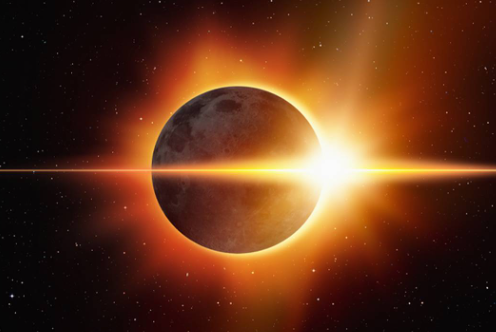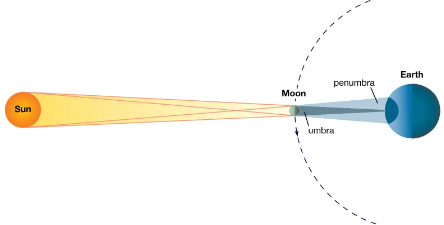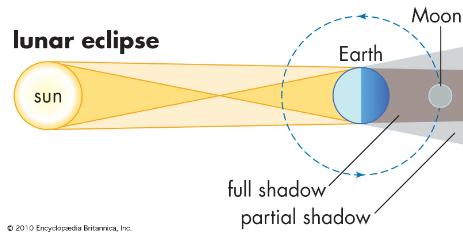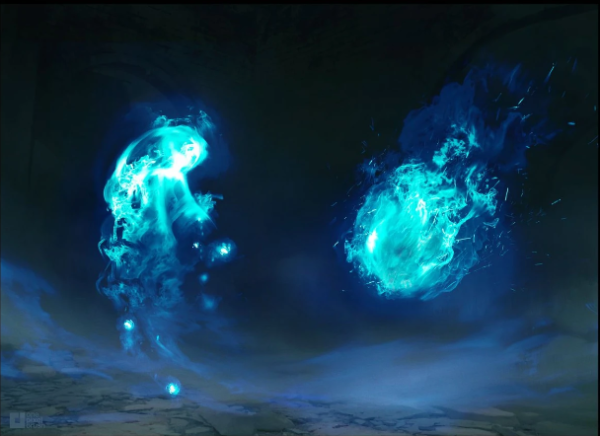Space Scope #1: Solar and Lunar Eclipses

January 11, 2023
If you’ve ever seen or heard of a solar eclipse, you know that it’s quite a popular and rare event around the globe. Such an unusual anomaly should be recognized and observed as long as you don’t go blind. But what are solar eclipses? How often do they happen? And how do they differ from lunar eclipses? Let’s dive in with this inaugural episode of Space Scope!
What are Solar Eclipses?
 A solar eclipse happens when the moon completely obscures the sun during a new moon. More specifically, the shadow of this eclipse is cut into two parts. The first is called an umbra, which is a cone that sunlight doesn’t pass through. The other is the penumbra, which is reached by light from a part of the sun’s disk. But when the sun is completely obscured, it’s called a total eclipse. The sun appears to be obscured by the moon, which means that the sun’s radiation is blocked, right? Not exactly. The penumbra still emits light, even if it’s being blocked by the moon. As such, you shouldn’t look at it. If you look at it without special glasses, it can negatively affect or destroy your retinas. The effect is called retinopathy, which is when solar radiation directly affects your eyes. The side effects of retinopathy can take as long as 4-12 hours to worsen or appear. It usually heals itself in 6 months, but prolonged sun exposure can cause permanent eye damage, leading to blindness. Solar Eclipses usually occur 2-5 times per year, but your location may change the visibility of the eclipse. Alright, That’s enough about solar eclipses. But what about lunar eclipses? Some people don’t even know what a lunar eclipse is.
A solar eclipse happens when the moon completely obscures the sun during a new moon. More specifically, the shadow of this eclipse is cut into two parts. The first is called an umbra, which is a cone that sunlight doesn’t pass through. The other is the penumbra, which is reached by light from a part of the sun’s disk. But when the sun is completely obscured, it’s called a total eclipse. The sun appears to be obscured by the moon, which means that the sun’s radiation is blocked, right? Not exactly. The penumbra still emits light, even if it’s being blocked by the moon. As such, you shouldn’t look at it. If you look at it without special glasses, it can negatively affect or destroy your retinas. The effect is called retinopathy, which is when solar radiation directly affects your eyes. The side effects of retinopathy can take as long as 4-12 hours to worsen or appear. It usually heals itself in 6 months, but prolonged sun exposure can cause permanent eye damage, leading to blindness. Solar Eclipses usually occur 2-5 times per year, but your location may change the visibility of the eclipse. Alright, That’s enough about solar eclipses. But what about lunar eclipses? Some people don’t even know what a lunar eclipse is.
What are Lunar Eclipses?
 For starters, lunar eclipses look vastly different than their solar counterpart. Instead of a black circle with an orange/yellow rim, it looks like the moon turns orange. Why is that? This is because, unlike solar eclipses, lunar eclipses do not involve the moon obscuring the sun. A lunar eclipse is when the earth’s shadow cast by the sun intersects with the moon, creating the reddish color you see in the picture above. And because of this fact, it is completely safe to look at with
For starters, lunar eclipses look vastly different than their solar counterpart. Instead of a black circle with an orange/yellow rim, it looks like the moon turns orange. Why is that? This is because, unlike solar eclipses, lunar eclipses do not involve the moon obscuring the sun. A lunar eclipse is when the earth’s shadow cast by the sun intersects with the moon, creating the reddish color you see in the picture above. And because of this fact, it is completely safe to look at with

the naked eye. No harm will be sustained to your eyes if you decide to observe one. Like a solar eclipse, umbras and penumbras make up the structure of a lunar eclipse. A lunar eclipse’s penumbra is the outer part of the earth’s shadow, which causes a penumbral eclipse. The umbra is the direct part of the earth’s shadow, which causes the deepest color orange seen above. Lunar eclipses also occur 2 times a year. However, most people will only see one per year since it takes place on different halves of the earth.
Solar Vs Lunar: What’s the Difference?
Now to get into the meat of this article, what’s the difference between the two? Well, the beginning warning should be to not mix the visibility of the two. Just because lunar eclipses are safe to look at doesn’t mean solar eclipses are. Now that that’s out of the way, let’s talk about how the shadow’s casting changes the way these eclipses occur. As discussed above, the moon obscures the sun, creating the shadow of the eclipse. This form of an eclipse is more direct, which is probably why it’s not safe to look at. A lunar eclipse, though, takes a more passive approach to it. The shadow that the earth casts is already existing, but the moon happens to intersect it, causing the eclipse. They also contrast in annuability, with most people only seeing 1 lunar eclipse per year as opposed to 2-3 solar eclipses per year. Sadly, after the pandemic, going outside to see eclipses has become less widespread, which is a shame. But who knows? Sometime in the future, maybe you’ll go outside to see one.
That’s all for this episode of Space Scope! In Episode 2, we’ll talk about shooting stars and meteors. See you all next time!!
Work Cited
NVision, NVision Eye Centers, 2022, https://www.nvisioncenters.com/. Accessed 10 12 2022.
Britannica, The Editors of Encyclopaedia. “solar eclipse”. Encyclopedia Britannica, 19 May. 2022, 82 Britannica.com . Accessed 21 November 2022.














